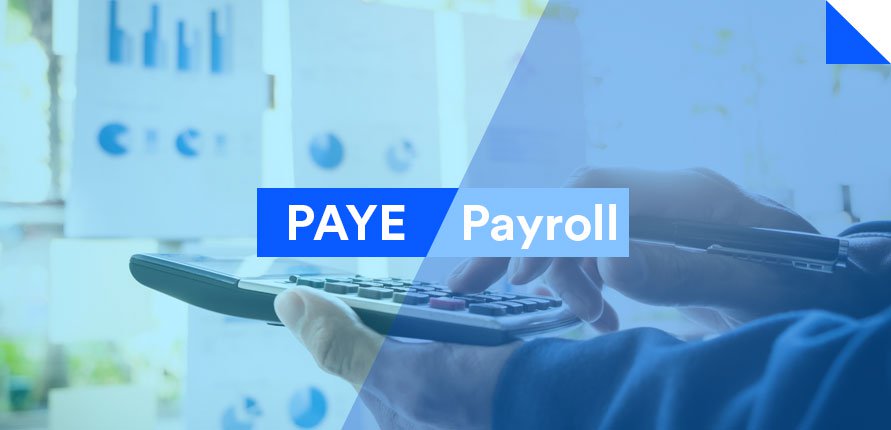
Just hired someone to help you out in your business? Or contemplating to grow your business with a battalion of the workforce? But worried about payslips, running payroll, and paying taxes through PAYE to HMRC seems a daunting task? We’ve prepared this complete guide to payroll, pay as you earn, and payslips. It has everything you need to know about PAYE and will answer all your questions regarding “how to run a payroll”.
PAYE stands for “Pay As You Earn”. It is a system of deducting and paying taxes and National Insurance contributions from employee’s pay as they earn it. This system of collecting taxes was first introduced during World War II to help the government in its times of financial crisis. Today, most of the employees pay their taxes through the system of PAYE.
Payroll means the process of evaluating employee’s pay, deducting income tax, national insurance contributions, and reporting it to HMRC.
Payment and Deductions
The employer, while making payments to the employee, is required to make deductions for PAYE.
Where,
- Payments refer to the basic salary or wages along with bonuses, tips, statutory pay, etc.
- Deductions mean the amount deducted for employee’s tax and national insurance contributions liability. It may also include amount deducted for student loan repayment or pension contributions.
The PAYE tax rates are as follows:
| Description | Rate of Tax | Year 2019-20 |
| Personal Allowance | 0% | Up to £12,500 |
| Basic tax rate | 20% | £12,501 to £50,000 |
| Higher tax rate | 40% | £50,001 to £150,000 |
| Additional tax rate | 45% | over £150,000 |
The deductions need to be based on the tax code issued by HMRC for each of the employees.
Furthermore, if the employee’s earnings exceed a certain limit, then the employer will also have to make Class 1 National Insurance Contributions. The amount to be paid depends on how much the employee earns their National Insurance category letter.
2. Running a Payroll
Employers may choose either to run payroll themselves or to hire payroll provider services. Payrolling involves calculating the amount of salaries or wages etc. due to an employee, the figures to be deducted from such amounts, producing payslips, and finally reporting and paying PAYE taxes to HMRC. Even the salaries/wages of the employees earning less than £118 per week need to be included on the payroll. If the employer intends to payroll benefits and expenses then he/she needs to register for payroll before the start of the tax year in which he/she wishes to begin running it.
3. Producing Payslip
Payslip is a document containing details like employee’s National Insurance number and tax code, pay rates, the total amount of pay, and deductions in the tax year so far.
A payslip should clearly indicate the gross pay (payment without any deductions), deductions for the payment period, payment after deductions, the number of hours worked if the payment is based on a zero-hour contract.
It may be produced using payroll software or any other software. These need to be printed or e-mailed to the employees on or before their payday.
4. Reporting HMRC
Every employer needs to report the employee’s payments and deductions to HMRC before each payday.
- Full Payment Submission (FPS) Through FPS the employer reports HMRC about payments made to employees and deductions made therein. The submission needs to be sent to HMRC before each payday even if the payment is made to HMRC quarterly or monthly.
- Employer Payment Summary EPS is a statement used to claim refunds/recoverable amounts from HMRC or making declarations to HMRC. EPS is used to:
- Reclaim statutory maternity, paternity, adoption or shared parental payments. These declarations are required to be reported to HM Revenue & Customs even if the employee receives an advance payment from the HMRC to cover them.
- Claim the employment allowance
- Reclaim Construction Industry Scheme (CIS) deductions.
- Claim National Insurance Contributions holiday for previous tax years
- Pay Apprentice Levy
- If no employees have been paid in a tax month then, the employer needs to send EPS instead of FPS.
Chronology
- The FPS needs to be sent to HMRC on or before the payday.
- The next tax month starts on the 6th of the following tax month.
- FPS submitted and the amount of tax and national insurance owed by the employer can be viewed from the 12th of the following tax month.
- EPS needs to be sent before the 19th of the following tax month in order to claim any reduction in the amount owed to HMRC.
- The net amount of tax needs to be paid by the 22nd of the following month.
5. Paying HMRC
The amount of tax and national insurance, as reported on FPS minus any reductions claimed through EPS, needs to be paid to HMRC on or before the 22nd of the following month.
If the employers generally pay less than £1,500 per month then they may choose to pay quarterly instead of monthly.
PAYE bill may be paid:
- On the same day- online or telephone banking, CHAPS
- 3 working days- debit card or credit card, Bacs, by cheque through the post, at the bank or the building society, Direct Debit (if it is set before)
- 5 working days- Direct Debit (if it is not set before)
6. Keeping Records
The employer is obliged to keep records of:
- Payments and deductions made
- Reports and payments made to an employee, (etc. redundancy payments, bank holiday payments, employment termination payments, etc.)
- Any leave and sickness absences of the employees
- Notices relating employee’s tax codes
- Taxable expenses and benefits
- In cases where the Payroll Giving scheme is used to enable the employees to donate to any charity directly from pay before tax, then all the documents related to such Payroll Giving schemes need to be kept.
These records have to be maintained for 3 years from the end of the tax year they relate to.
PAYE and Pensions
The money received as pensions is also chargeable to PAYE. Thus, the amount of pension received by an individual is actually net taxes, which means tax has been deducted at source.
The pension provider deducts the amount of taxes on the pension holder’s behalf and pays the same to HMRC. The provider will also take off the taxes from the state pensions an individual is entitled to.
PAYE forms
There are several PAYE forms in use. Each has its own purpose.
- Form P45: Given to employee by an employer when the former leaves the job. It shows the amount of tax that has been paid within the related tax year so far.
- Form P60: Given to employees by employers after the end of a tax year. The form contains details of the amount of salary and tax paid out of the employee’s salary for the relevant tax year. This form is often useful when the employee is required to prove the amount of tax paid to employees in case one needs to claim back overpaid tax, to apply for tax credits or in case they have applied for loan or mortgage then the document is being treated as a proof of income.
- Form P11D: If an employee receives any ‘benefit in kind’ from an employer, then the employer needs to submit this form to HMRC. This form records the monetary value of each benefit. An employer may provide an employee with a copy of P11D.
- Form P87: It is a form that can be used by employees to claim tax relief for allowable employment expenses. If the allowable expenses are less than £2,500, the employee can claim tax relief through the P87 form, but if the allowable expenses are more than £2,500 then these can be claimed only by filing a self-assessment return.
Conclusion
In this article, we’ve tried to cover all the important aspects of PAYE and payroll. After reading about it all, are you still feeling ‘not so fascinated’ by the idea of doing all this by yourself? Don’t worry; we can do it for you. Click here to know more about our payroll services.












